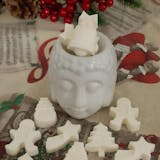We are in peak season for this business. Due to the high number of orders, the deadline may extend 24-72 hours to the normal deadline. Plan your orders with some time. . Our preferred method of contact is email.

We are in peak season for this business. Due to the high number of orders, the deadline may extend 24-72 hours to the normal deadline. Plan your orders with some time. . Our preferred method of contact is email.
-
FOR THE EXPLORERS
▾
- MESSAGE IN A CANDLE
- LET'S LIGHT TOGETHER
- LOVERS COLLECTION
- LET'S MELT TOGETHER
- 1993 THE COLLECTIONS
- LUXURY CANDLES
- LUXURY REED DIFFUSERS
- LUXURY WAXMELTS
- GLASS MELT BURNERS
- CRYSTAL OBSESSION
- TINY COLLECTIONS
- LIMITED EDITIONS
- SMOKE GREY SET BURNER AND WAXMELTS
- HOME COLLECTIONS
- HOME COLLECTION Nº1
- HOME COLLECTION Nº2
- HOME COLLECTION Nº 3
-
FOR THE MAKERS
▾
- FOR CANDLES
- CANDLE CONTAINERS
- OTHER CONTAINERS
- CONTAINER WAXES
- ALL WAXES
- WICKS
- CRYSTAL OBSESSION
- WAXES DYES BEKRO COLORS
- CANDLE PACKAGING
- ACCESSORIES FOR CANDLE MAKING
- SAFETY LABELS & DUST COVERS
- CANDLE KITS
- TECHNICAL E-BOOKS
- FOR REED DIFFUSERS & ROOM MISTS
- BASE FOR ROOM SPRAYS
- BASE AUGEO & PERFUMER'S ALCHOOL
- DIFFUSER BOTTLES
- FIBER REEDS,RATTAN & SOLA FLOWERS
- GLASS BOTTLES FOR SPRAY & PERFUME
- BOTTLES FOR SOAPS & ROOM MISTS
- CAPS AND PUMPS
- DIFFUSER PACKAGING
- SAFETY LABELS
- FRAGRANCES ▾
- Cart Cart
GOLDEN WAX 494 FOR WAX MELTS
€9,50 EUR
– Sold OutDescription
This all-natural soy wax produced by global wax giant AAK under the Golden Brands name was specifically developed and formulated for containers and melts.
Golden Wax 494 is made in the USA. This version has an excellent scent throw, exhibits vibrant colors, and releases easily from molds. This wax uses a 100% soy and botanical oil formula that creates a smooth appearance. Due to the high amount of botanical additives, this wax blend is not designed to burn in a jar.
Golden Wax 494 is the world's most popular soy melt wax because this wax outperforms a lot of soy melt blends in the market with excellent mold release, depth of color, and scent loading. GW494 is highly stable and is delivered in flake form, making it ideal for low- to medium-volume makers.
If you look for the Swedish version ( with no botanical anti-frosting additive ) look for Y50 here
- Biodegradable
- Natural, 100% GMO-free soybean
- Devoid of toxic substances
- Without synthetic additives
Available in pastilles or in small chunks according to the manufacturer's availability
Product Specifications
Supplied in pastilles or small blocks ( depending on the manufacturer's availability)
Golden Wax 494 does not need to be blended with paraffin or other non-plant-based waxes. In addition, Golden Wax provides significant bloom/frost reduction. This premium botanical wax is ideal for use in wax melts, tarts, and pillar candles.
Benefits
- Reduced set-up time
- Great mold release
- Allow for vibrant colors
- Create a fragrance throw comparable to paraffin
- Compatible with standard candle-making equipment
- Easily modified and combined with other waxes
- Versatile and adaptable, for easily customizable blends
Color
Most dyes work with Golden Wax 494 including powder, liquid, or our Bekro dyes. If you wish to make your wax darker, add a little black dye to the color you are using. To lighten use white dye.
Fragrances
Golden Wax 494 may be used with fragrance at levels up to 10%, however, we recommend approximately 8% as this will give an excellent scent throw. Add fragrance close to the pour temperate, around 60 degrees, for best results. The wax will hold 10%+ of most fragrances, although 7-8% is usually more than enough.
Max. Fragrance Load: 10%
Melting
The melting temperature of Golden Wax 494 is 49ºC - 52°C and it can be heated to 80 - 85°C. Allow the wax to cool to your desired pour temperature, add the fragrance at approximately 70°C, and mix well - be sure to stir/mix the wax while melting. Higher temperatures may cause the wax to discolor.
Pouring
Pour temperatures may vary according to type & size, fragrance & dye used. Pour temperatures should be reasonably high (between 60-71°C) unless you are pouring into plastic clamshells, so we recommend, only in that case, no higher than 55°C.
Cooling
Cool undisturbed melts at room temperature (about 21-24°C). They should be allowed to sit undisturbed for 48 hours before test burning.
Cure Time
We would suggest a cure time of 10-14 days before burning.
Made in Sweden
Recommendations
The wax will hold 10%+ of most fragrances, although 7-8% is usually more than enough.
Pour Temperature: 60 - 70°C (Testing has shown 60°C to be an optimum temperature for pouring )
Dye: Bekro Dye is most suitable (Mix at 1-2g dye per 100g wax), depending on the shade you wish to achieve
We would suggest a cure time of 10-14 days before burning.
TOP TIP: This wax also makes an ideal base for use in scoopable wax.
Recipe for scoopable wax:
When combined with pure rapeseed wax at a ratio - of 75% of 494 Golden Wax to 15% of Rapeseed.
Always with sustainability in mind, know more about sustainable sourcing of vegetal wax and the statement of AKK
How to take the vegetal mold of the silicon mold
Taking vegetable wax molds out of silicone molds can be a delicate process to prevent breakage or damage. Here's a step-by-step guide with some tips and tricks to make it easier:
-
Prepare Your Work Area:
- Ensure your workspace is clean and dry.
- Make sure the silicone mold and the vegetable wax are at room temperature.
-
Use a Release Agent:
- Apply a mold release agent to the inside of the silicone mold before pouring in the vegetable wax. This can be a silicone-based spray or a specialized mold-release product.
- Allow the release agent to dry or set as per its instructions.
-
Pour the Wax Carefully:
- When pouring the melted vegetable wax into the silicone mold, do it slowly and steadily to minimize air bubbles and ensure it fills all the details of the mold.
-
Cooling and Setting:
- Allow the wax to cool and set completely. This may take several hours or overnight depending on the size and thickness of the wax mold.
-
Gently Flex the Mold:
- Before attempting to remove the wax from the mold, gently flex the silicone mold by pressing on the sides. This can help loosen the wax from the mold's surface.
-
Start at the Edges:
- Begin removing the wax mold from the silicone by carefully peeling back the edges. Use your fingers to create a gap between the wax and the mold.
-
Avoid Force:
- Do not force the wax out of the mold. If it feels stuck, gently flex the mold a bit more and try again.
-
Use a Soft Tool:
- If necessary, use a soft, non-abrasive tool like a silicone spatula or a plastic spoon to help ease the wax out of the mold. Be very gentle to avoid damaging the wax.
-
Warm the Mold Slightly:
- If the wax is particularly stubborn, you can warm the silicone mold slightly with a hair dryer or a heat gun on low heat. This can help loosen the wax without melting it.
-
Patience is Key:
- Take your time and work slowly. Rushing the process can lead to breakage.
-
Inspect for Breaks:
- Once you've successfully removed the wax mold, inspect it carefully for any cracks or breakage. If you find any, you might need to re-melt the wax and make a new mold.
-
Clean and Store:
- Clean the silicone mold after use, and store it properly to maintain its condition for future use.
Remember that practice makes perfect. It may take a few tries to get the hang of removing wax molds from silicone molds without breaking them. Additionally, the quality of your silicone mold and the type of wax you use can also influence the ease of removal. High-quality molds and proper techniques will typically yield better results
Silicone molds are known for their non-stick properties, and in many cases, they do not require a release agent. However, whether you need a release agent for silicone molds can depend on several factors:
-
Type of Silicone Mold: Most silicone molds designed for crafting, baking, or soap-making are naturally non-stick, and you can often use them without a release agent.
-
Complexity of the Mold: If you're using a silicone mold with intricate details, deep crevices, or undercuts, it may be a good idea to use a release agent to ensure easy removal of the molded item.
-
Type of Material Being Molded: Some materials may have a tendency to stick to silicone more than others. For example, certain types of wax, resin, or clay may require a release agent, while others may not.
-
Personal Preference: Some individuals prefer to use a release agent as an added precaution to ensure that their molded items come out easily and without any risk of damage.
-
Reuse of the Mold: Using a release agent can also prolong the life of your silicone mold by preventing any build-up or residue from repeated use.
In many cases, you can start by trying to use your silicone mold without a release agent. If you find that the material sticks or has difficulty coming out of the mold, then consider using a suitable release agent. Common release agents include silicone mold release sprays, vegetable oil, or even a light dusting of cornstarch for certain applications.
Ultimately, the decision to use a release agent with your silicone mold should be based on your specific project and the materials you're working with. Experimentation may be necessary to determine the best approach for your particular situation.
SHOP THE RANGE
LEGAL INFO & CONTACT
© 2024 Eco Candle Project .












